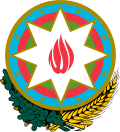| Image | Name | Description |
|---|
| | Motto of Azerbaijan. Azerbaijani land is famed as "The land of fire" due to its natural burning gas resource from ancient times [1] (because of existence of oil fields). [1] Religious notions of fire worshippers were connected to this phenomenon. Ateshgah ("A place of fire") – temple of Zoroastrian worshippers is located in the outskirts of Surakhani village where burning gas goes out form ancient times. Nowadays, the symbol of fire is broadly used in the country. [2] The fire is considered the symbol of Azerbaijan. [3] [4] |
| | Maiden Tower is an ancient serfdom construction at a coastal side of "Old City" – Icheri Sheher in Baku. The tower is considered one of the most essential parts of maritime façade of the capital. There are many legends about the origin of the Maiden Tower, many of which are connected to the meaning of the word "maiden". The tower was built in two stages: the first is dated to the pre-Islamic era, but an inscription with an indication of the architect’s name belongs to the 12th century. The tower can be seen in pictures by eminent artists. A poem, film and ballet are dedicated to the tower. In 1964, the Maiden Tower became a museum, and in 2000 it was included in a UNESCO List of World Heritage Sites in Azerbaijan. |
| | Is an architectural reserve to the south from Baku. It’s famed for cultural landscape of rock paintings. The paintings were found out in three parts of the rocky plateau and once inhabited caves, traces of settlements and burial vaults indicates a dense occupation of this territory in a period between upper paleolith and the Middle Ages. In 1966, Gobustan was declared a reserve, and in 2007, the cultural landscape of rock paintings of Gobustan was included into the list of the world cultural heritage of UNESCO. |
| | The pomegranate is considered one of the symbols of Azerbaijan. [6] Annually in October, a cultural festival is held in Goychay, Azerbaijan known as the Goychay Pomegranate Festival. The festival features Azerbaijani fruit-cuisine mainly the pomegranates from Goychay, which is famous for its pomegranate growing industry. |
| | Is a traditional music genre characterized by a great level of improvisations. Mugham in Azerbaijan is generally performed to the accompaniment of saz players which include: tar, kemancha and daf players. Frequently the daf player is a singer (khanende). Themes of mughams are often taken from lyrics – love and philosophic poetry. As a rule, ghazels of classics such as Nizami, Fuzûlî, Khaqani, Vidadi, Nasimi, Molla Panah Vagif and others are the texts of mughams. In 2008, mugham was included into a list of masterpieces of oral and non-material cultural heritage of UNESCO. |
| | Is a mountain-steppe racing and riding horse developed in Karabakh. They were developed under the influence of Iranian, Turkoman and then Arabian horses. It has influenced upon riding-horse breeding of southern Russia and several countries of Southern Europe (Poland and France). They were used for improvement of local horses of the South Caucasus Breeding work for improvement of Karabakh horses was conducted once in Aghdam horse breeding plant of the Azerbaijan SSR. At present, there are 2 horse breeding plants in Azerbaijan for popularization of Karabakh race – in Lambaran village of Barda Rayon and in Agstafa Rayon. Besides that, a number of private enterprises also function in the republic alongside the latter ones. |
| | Tar is a plucked string instrument with a long neck. Performance on tar and also the arts of its production is developed throughout whole territory of Azerbaijan. Skills connected to this tradition are of great importance in formation of cultural identity of Azerbaijanis. Tar is considered the musical symbol of Azerbaijan. In 2012, Azerbaijani arts of performance on tar and mastery of its production was included into the list of masterpieces of oral and non-material cultural heritage of UNESCO. |
| | Carpet weaving is the most broadly spread classic type of handicraft in Azerbaijan. [8] Guba, Shirvan, Ganja, Qazakh, Garabakh and Baku are the main centers of carpet weaving in Azerbaijan. Azerbaijani carpets are distinguished for their bright colors, with harmonizing intensive tints. [8] Carpet weaving – is a part of family tradition which is passed both orally and in the course of practical lessons. In 2010, traditional carpet weaving arts of Azerbaijan was included into the list of masterpieces of oral and non-material cultural heritage of UNESCO. [9] Carpets are also considered the symbol of Azerbaijani nation. [10] |
| | Buta ornament famed in Eastern countries in a broad territory is a typical detail of Azerbaijani national ornament. [11] Buta motif is often used by Azerbaijani master. There are a lot of types of buta and some of them have their own symbolic meaning. [12] Today, this ornament is widely used in Azerbaijan: on carpets, textiles and decoration of buildings. Buta is considered the symbol of Azerbaijan. [13] [14] [15] |
| | Oil industry is a leading branch of Azerbaijani economy. Rich oil deposits in Azerbaijan were famed for a long time. The first oil well was drilled in Baku in 1848. Azerbaijani oilmen produced 80% of fuel of whole country during World War II. [16] The world’s oldest offshore oil platform is also located in Azerbaijan (Oil Rocks). [17] Oil became the symbol of Azerbaijan. [18] |















